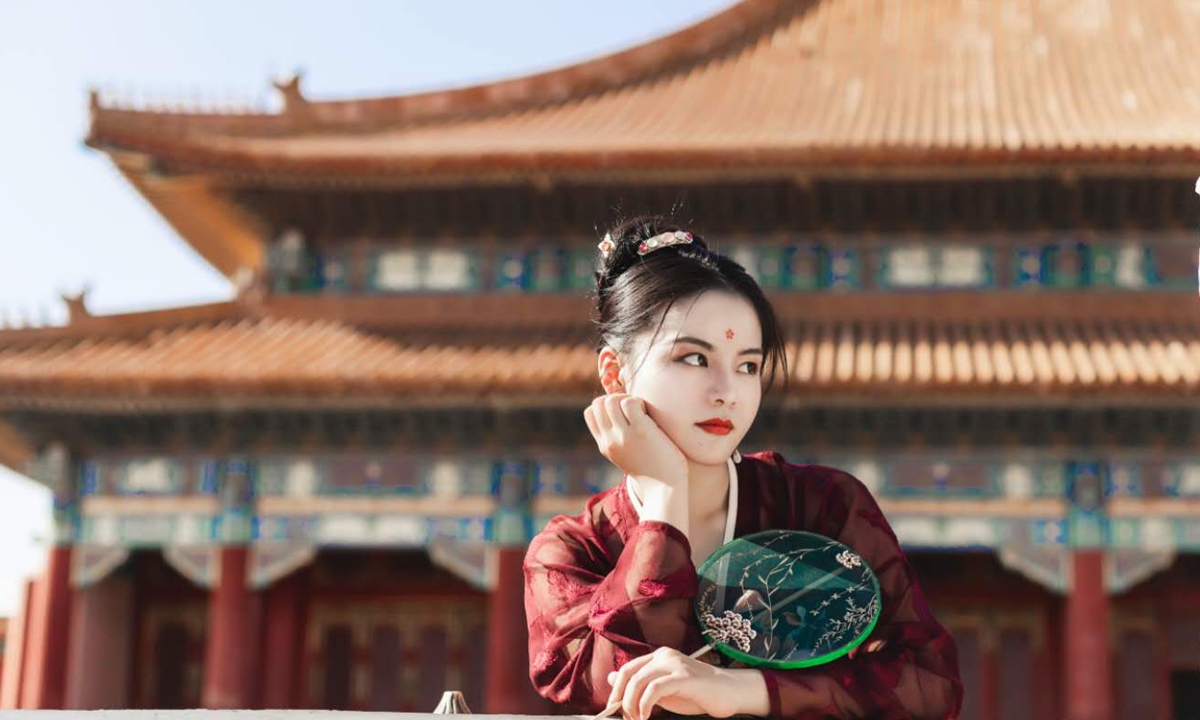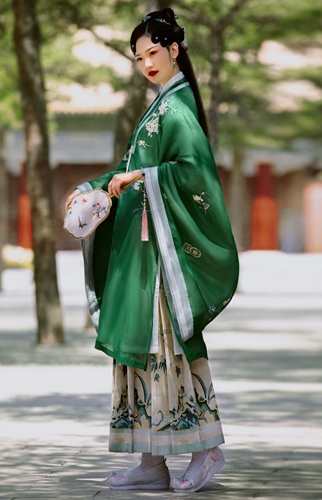
Chinese women dressing in Hanfu. Photo: Courtesy of Jinfengchangsu

Chinese women dressing in Hanfu. Photo: Courtesy of Jinfengchangsu
Chen Xiaofang, a 26-year-old fresh college graduate, has placed an order online for a piece of a long gown, embroidered with flowers and bead or Hanfu - an ancient garment traditionally worn by the Han ethnic group - amid a trend that the Chinese traditional costume is making a comeback.
The Beijing-based white-collar worker's appetite for Hanfu was awakened in recent days as she is seeing an increasing cohort of young people clad in them in the streets as well as in parks and sightseeing scenic spots.
"Han clothing looks so gorgeous at the first sight, and will fulfill my fantasy for a traditional Chinese fair lady. It, an emblem of Chinese people's pride, also carries a lot of weight in representing traditional Chinese culture and history," Chen told the Global Times on Monday.
As a newcomer to the subculture, Chen had spent about 500 yuan ($77.65) buying the garment. Compared with Chen, Huang Lanlan, a Shanghai-based fan of Hanfu, spent more, topping over 70,000 yuan to date.
Huang was drawn by the beauty of Han costume in 2014, when she by chance participated in a local Hanfu demonstration show for Qixi Festival, also called the Chinese Valentine's Day. Her individual like has amassed to a collective fever in seven years, during which she has met friends sharing similar interests and they organized Hanfu-themed gatherings.
"My spending on Han clothing has now totaled around 70,000 yuan, with the average price per piece at around 500 yuan. As the market for Han costumes expands, prices have fallen significantly and become more affordable to younger people," Huang said, adding that in the past, a piece of Ming Dynasty Han clothing could cost more than 1,000 yuan.
In addition to clothing, Huang also spent another 20,000 to 30,000 yuan on exquisite headpieces, make-ups and photographs.
"In terms of the level of spending, I'm just in the middle. Some avid lovers of Han clothing do not set limits on their budgets, and they are buying designed luxury item as collections," Huang told the Global Times on Monday.
Huang's words underscores a rapidly-growing market as the ancient clothing renaissance is gaining tract. According to a report released by iiMedia, the number of China's Hanfu enthusiasts has nearly doubled, from 3.56 million in 2019 to more than 6 million at the end of 2020. Among which, the Z-generation belong to the main consumer groups.
In 2021, the number is expected to further climb to 6.89 million, opening a market that could value at 10.2 billion yuan, the report showed.
An industry on the riseIn Cao county, East China's Shandong Province which reportedly accounts for over one third of Hanfu sales across the country, factory workers across the supply chain - from production factory, fabric supplier to embroidery plants -have been stretching their arms to catch up with the incoming orders, which have begun to soar since the second quarter.
Cao country is home to over 2,000 merchants involved in Han clothing, according to media reports.
"Our factory's customized orders for Han clothing have already been scheduled to the end of July," a manager surnamed Zhu from a Hanfu manufacturing and supply factory based in Cao county told the Global Times on Sunday.
Echoing with Zhu's strained capacity, an employee of Minghuatang, a high-end luxurious Hanfu brand, also told the Global Times on Monday that its factory's production has been fully scheduled until March 2022. The price of its Han clothing ranged from more than 1,000 yuan to close to 10,000 yuan a piece.
Zhu's factory currently provides Hanfu for 40 to 50 physical stores across the country. The factory's daily production capacity for a 6-meter Han skirt is about 2,000 sets and for a 4.5-meter Han skirt, the production capacity is higher than 2,000.
Zhu noted that as local supply chain is quite complete, he plans to further increase production capacity to deal with the surging orders.
According to Zhu, his factory has once received overseas orders from a Chinese international student group based in Los Angeles, who ordered a batch of Hanfu for local Chinese students to wear.
Another manager surnamed Zhang of a Han clothing company in Cao county, told the Global Times on Monday that they now produced and sold more than 10,000 pieces of Han clothing every month, significantly higher than sales last year.
"The impact of the coronavirus is gradually easing, and many Hanfu events scheduled last year was postponed to open in recent days, which lead to an explosive demand for the outfit," Zhang said.
Accompanying business On par with the young generation's rising purchasing power and broader recognition for traditional culture, the prospect for the Hanfu market stands to be lucrative, which in turn has attracted venture capitals (VC) that are eager to get a slice of the pie.
According to media reports, leading Chinese Hanfu brand Shisanyu has raised more than 100 million yuan in its A-round fund-raising in April, led by Chinese VC Loyal Valley Capital and China's Youtube-like video platform Blibli. Other top-level Hanfu makers, including Chonghuihantang and Huashangjiuzhou, have also received funds from VC from 5 million yuan to up to 100 million yuan.
China's social media platforms, such as Weibo and Douyin, have helped fuel the popularity of Hanfu. For example, the recent look of Chinese diving queen Guo Jingjing - in Han clothing - at a Chinese culture promotion event - generated a buzz on Weibo.
Youngsters are growing to be more conscious to share their photos and videos of themselves dressing in traditional costume on social networks. And this led to a burgeoning business on Hanfu make-ups and photographs.
Cheng Pei has opened the Jinfengchangsu photo studio in Beijing close to the Palace Museum, offering customers a full Hanfu shooting experience from dressing to shooting.
"The number of customers coming in store for our Hanfu shooting services has increased significantly after this year's Spring Festival, growing by more than 50 percent from last year," Cheng told the Global Times.
Cheng noted that his studio has been hiring new members recently in order to deal with soaring customer orders, even though he has already recruited several employees at the end of last year.
But industry observers showed concerns over Hanfu's intellectual property (IP) issue, which they worried could deprive the industry of creativity and originality in the long term.
"It takes time for a brand to design a boutique Hanfu, with carefully chosen fabric and intricate print details. But some 'copycats' merchants could easily copy the design and replace it with inferior prints, so that they could quickly churn out in large scale and snap up market share," an industry insider told the Global Times on condition of anonymity.
The insider added that it takes months for an original Hanfu to apply and receive a patent, but during the time, the "copycat" merchants would already have sold out their copied Han clothing.
"We hope the industry could be developed in a more regulated and healthy way in the future," she said.





